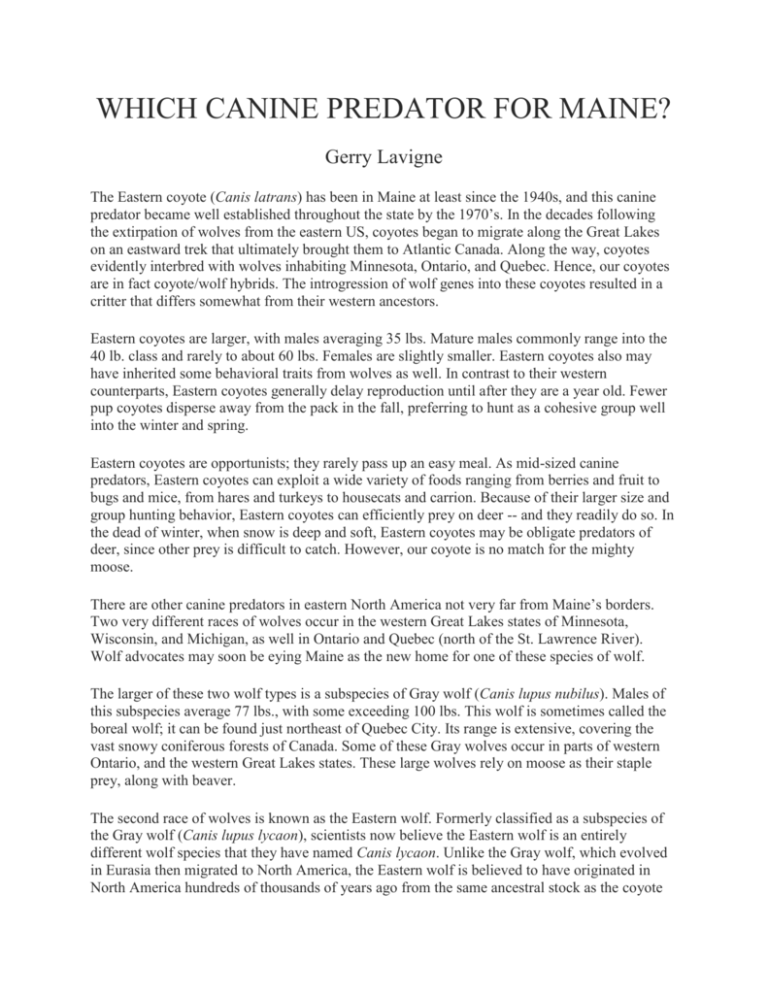which canine predator for maine?
advertisement

WHICH CANINE PREDATOR FOR MAINE? Gerry Lavigne The Eastern coyote (Canis latrans) has been in Maine at least since the 1940s, and this canine predator became well established throughout the state by the 1970’s. In the decades following the extirpation of wolves from the eastern US, coyotes began to migrate along the Great Lakes on an eastward trek that ultimately brought them to Atlantic Canada. Along the way, coyotes evidently interbred with wolves inhabiting Minnesota, Ontario, and Quebec. Hence, our coyotes are in fact coyote/wolf hybrids. The introgression of wolf genes into these coyotes resulted in a critter that differs somewhat from their western ancestors. Eastern coyotes are larger, with males averaging 35 lbs. Mature males commonly range into the 40 lb. class and rarely to about 60 lbs. Females are slightly smaller. Eastern coyotes also may have inherited some behavioral traits from wolves as well. In contrast to their western counterparts, Eastern coyotes generally delay reproduction until after they are a year old. Fewer pup coyotes disperse away from the pack in the fall, preferring to hunt as a cohesive group well into the winter and spring. Eastern coyotes are opportunists; they rarely pass up an easy meal. As mid-sized canine predators, Eastern coyotes can exploit a wide variety of foods ranging from berries and fruit to bugs and mice, from hares and turkeys to housecats and carrion. Because of their larger size and group hunting behavior, Eastern coyotes can efficiently prey on deer -- and they readily do so. In the dead of winter, when snow is deep and soft, Eastern coyotes may be obligate predators of deer, since other prey is difficult to catch. However, our coyote is no match for the mighty moose. There are other canine predators in eastern North America not very far from Maine’s borders. Two very different races of wolves occur in the western Great Lakes states of Minnesota, Wisconsin, and Michigan, as well in Ontario and Quebec (north of the St. Lawrence River). Wolf advocates may soon be eying Maine as the new home for one of these species of wolf. The larger of these two wolf types is a subspecies of Gray wolf (Canis lupus nubilus). Males of this subspecies average 77 lbs., with some exceeding 100 lbs. This wolf is sometimes called the boreal wolf; it can be found just northeast of Quebec City. Its range is extensive, covering the vast snowy coniferous forests of Canada. Some of these Gray wolves occur in parts of western Ontario, and the western Great Lakes states. These large wolves rely on moose as their staple prey, along with beaver. The second race of wolves is known as the Eastern wolf. Formerly classified as a subspecies of the Gray wolf (Canis lupus lycaon), scientists now believe the Eastern wolf is an entirely different wolf species that they have named Canis lycaon. Unlike the Gray wolf, which evolved in Eurasia then migrated to North America, the Eastern wolf is believed to have originated in North America hundreds of thousands of years ago from the same ancestral stock as the coyote (Canis latrans). Accordingly, Eastern wolves and coyotes share a great deal of genetic composition. The Eastern wolf is considerably smaller than the Gray wolf. Males average a little over 60 lbs, but they can attain 80 or more lbs. Eastern wolves cannot efficiently prey on moose. They are deer specialists, with beaver being secondary. Unlike the coyote, neither wolf species relies heavily on small prey. They are large game hunters year-round. Scientists believe that Eastern wolves historically occurred in the deciduous forests of the eastern US and adjacent parts of Canada, where the dominant ungulate was white-tailed deer. Currently, Eastern wolves comprise the majority of wolves inhabiting Minnesota, Wisconsin, and the Upper Peninsula of Michigan. In Canada, Eastern wolves inhabit the deer range of southeastern Ontario, and southwestern Quebec (north of the St. Lawrence). Recently, the US federal government removed the wolves of the western Great Lakes states from the Endangered Species List. When they did so, federal officials designated these wolves as Gray wolves (Canis lupus). Legally, this means there is no US population of Eastern wolves. I expect wolf advocates will soon demand a reintroduction effort for Eastern wolves here in the eastern US. Maine will be a prime target for any wolf reintroduction proposal. Establishment of a wolf population of either species will be controversial. Federal protection under the Endangered Species Act will affect coyote hunting and trapping opportunity, availability of white-tailed deer and perhaps moose for hunting, human conflicts (loss of dogs and livestock), and possibly land-use practices. Before any wolf restoration project occurs, Mainers should weigh the consequences very carefully.








